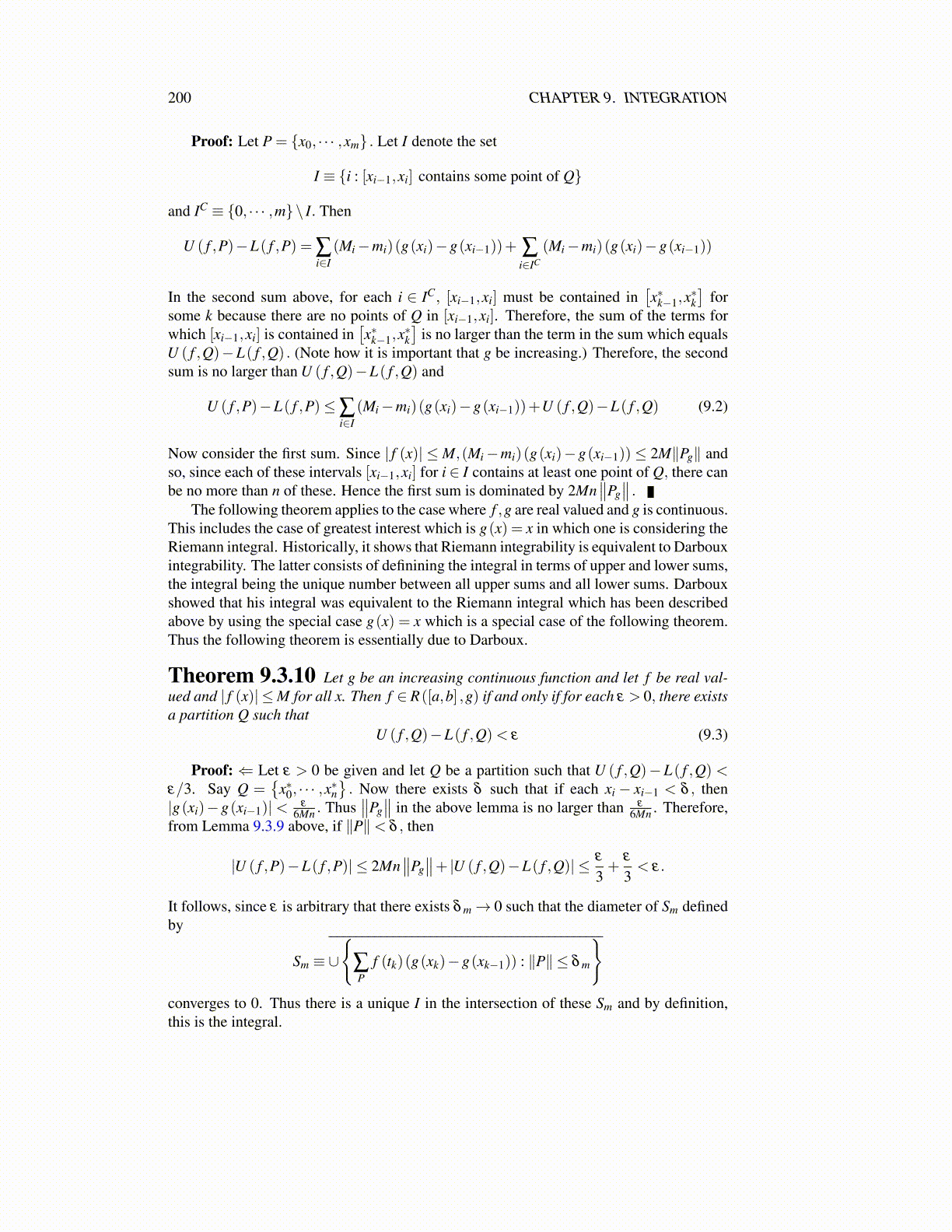
200 CHAPTER 9. INTEGRATION
≤n
∑k=1
K((
M fi −m f
i
)+(
Mhi −mh
i
))(g(xi)−g(xi−1))≤ K (ε + ε)
Since ε is arbitrary, this shows k ( f ,g) ∈ R([a,b] ,g) . In case this went by too fast, see thefollowing explanation.
In case there is a question about the assertion that(Mk
i −mki
)≤ K
((M f
i −m fi
)+(
Mhi −mh
i
))Pick xM,xm ∈ [xi−1,xi] such that k ( f (xM) ,h(xM)) > Mk
i − ε, k ( f (xm) ,h(xm)) < mki + ε.
Then (Mk
i −mki
)≤ k ( f (xM) ,h(xM))− k ( f (xm) ,h(xm))+2ε
≤ K (| f (xM)− f (xm)|+ |h(xM)−h(xm)|)+2ε ≤ K((
M fi −m f
i
)+(
Mhi −mh
i
))+2ε
and since ε is arbitrary, this shows the assertion.This theorem could be generalized by letting k be continuous, but if you want to do
everything right, the context of Riemann integration is not the right place to look anyway.Much more satisfactory results are available in the theory of Lebesgue integration. I amtrying to keep things simple without excluding the most important examples.
Here is an example of the kind of thing considered obtained from the above theorem.
Example 9.3.14 Let f ,h be Riemann Stieltjes integrable, real valued functions with respectto g an increasing integrator function. Then so is max( f ,h) ,min( f ,h) ,a f +bh for a,b realnumbers, f h, and likely many other combinations of these functions.
The only claims not obvious are the one about f h and max( f ,h) ,min( f ,h). However,g,h are bounded by assumption. Therefore, h, f have all values in some interval [−R,R] .Let k (a,b)≡ ab for (a,b) ∈ [−R,R]× [−R,R].∣∣k (a,b)− k
(â, b̂)∣∣≤ |ab− âb|+
∣∣âb− âb̂∣∣≤ R |a− â|+R
∣∣b− b̂∣∣
As to max( f ,h) , it equals | f−h|+ f+h2 which clearly satisfies the necessary condition.
Note that this theorem includes the most important example in which g(t) = t, theRiemann integral.
The following corollary gives many examples of functions which are integrable. Thiscorollary includes the case of Riemann integrability of a piecewise continuous function.This was first shown by Riemann. However, it is important that either f or g is continuousat the exceptional points for f .
Corollary 9.3.15 Let g be an increasing function defined on [a,b] and let | f | be bound-ed by M and f is continuous on [a,b] except for {c1, · · · ,cr}. At these points either f or gis continuous. Then
∫ ba f dg exists.
Proof: By Theorem 9.3.7, I just need to show that there is a partition P such thatU ( f ,P)−L( f ,P) < ε . Let
∥∥P̃∥∥ < δ , P̃ = a = y0 < · · · < yn = b where δ is so small that
if some ci ∈ [yk−1,yk] , then for Mk,mk having the meaning described above as sup and infof f on the kth interval,
|(Mk−mk)(g(yk)−g(yk−1))|<ε
5r(9.4)